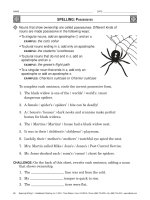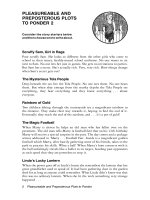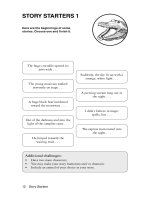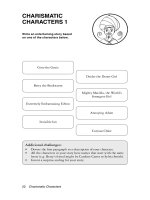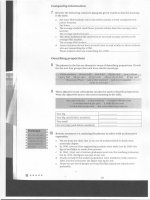WRITING SUCCESSFUL ACADEMIC BOOKS doc
Bạn đang xem bản rút gọn của tài liệu. Xem và tải ngay bản đầy đủ của tài liệu tại đây (1.36 MB, 192 trang )
WRITING SUCCESSFUL
ACADEMIC BOOKS
‘Publish or perish’ is a well-established adage in academia. Never has the
pressure on academics to publish been greater. Yet the prospect of writ-
ing a book can seem daunting, while the business of getting it published
may be mystifying. Written by an expert in academic publishing, Writing
Successful Academic Books provides a practical guide to both writing and
getting published. It covers all stages of academic authorship from develop-
ing the initial idea for a book through to post-publication issues, showing
how to avoid the common pitfalls and achieve academic and professional
success through publication. Full of real-life examples, including a sample
book proposal, the book covers everything you need to know to build up an
authorial career. is is an invaluable guide for academic authors – prospec-
tive or established – in all disciplines.
is Director of e Professional and Higher Partnership
Ltd, where he specialises in academic publishing. He is Visiting Professor
at Beijing Normal University, China, teaches academic authorship online at
the University of Tartu, Estonia, and mentors numerous academic authors
in the UK. He holds qualifi cations from Cambridge University, the Open
University, and the University of Malta. His previous books include Writing
Successful Textbooks .
WRITING SUCCESSFUL
ACADEMIC BOOKS
ANTHONY HAYNES
Cambridge, New York, Melbourne, Madrid, Cape Town, Singapore,
São Paulo, Delhi, Dubai, Tokyo
Cambridge University Press
e Edinburgh Building, Cambridge , UK
Published in the United States of America by Cambridge University Press, New York
www.cambridge.org
Information on this title: www.cambridge.org/
© Anthony Haynes
is publication is in copyright. Subject to statutory exception
and to the provisions of relevant collective licensing agreements,
no reproduction of any part may take place without the written
permission of Cambridge University Press.
First published
Printed in the United Kingdom at the University Press, Cambridge
A catalogue record for this publication is available from the British Library
Library of Congress Cataloguing in Publication data
Haynes, Anthony.
Writing successful academic books / Anthony Haynes.
p. cm.
---- (hardback)
. Authorship. . Academic writing. . Scholarly publishing. I. Title.
.
′.–dc
---- Hardback
---- Paperback
Cambridge University Press has no responsibility for the persistence or
accuracy of URLs for external or third-party internet websites referred to in
this publication, and does not guarantee that any content on such websites is,
or will remain, accurate or appropriate.
e advice and opinions expressed in this book are solely those of the author and
do not necessarily represent the views or practices of Cambridge University Press.
No representations are made by the Press about the suitability of the information
contained in this book, and there is no consent, endorsement or recommendation
provided by the Press, express or implied, with regard to its contents.
To Karen, Frances, Jonty, and Simon
vii
Contents
List of fi gures page ix
List of tables x
List of boxes xi
Foreword by Jaan Mikk xiii
Preface xv
Foundations
Contexts
Getting commissioned
Contracts and agents
Processes ( )
Processes ( )
Craft
Dissertations
Time
People
Contentsviii
Next
Appendix A. Proposal guidelines
Appendix B. Sample book proposal
Appendix C. Guide to contracts
Notes
References
Index
ix
Figures
. Graphical analysis of the components of tone page
. Graphical analysis of the components of tone in
(A) Coakley and (B) Dick
. Decision tree for responding to peer reviews
x
Tables
. Grid page
. Complex grid
. Grid for this chapter
. Grid for this chapter (refi ned)
. Symbols
. New edition scale
xi
Boxes
. List plan page
. Chapter plan based on questions
. Paragraph openings from Bertrand Russell, ‘ e
Romantic Movement’
. Opening sentences from fi rst half of Chapter of Liz
omas, Widening Participation in Post-Compulsory
Education
xiii
Experienced editor and Visiting Professor at Beijing Normal
University Anthony Haynes has provided a highly useful guide for
authors of academic books. Authors are very competent in their
specialism; however, they may encounter problems in negotiations
with the publisher, in presenting their material in book form, etc.
Anthony Haynes shares his broad competence on all the stages of
writing and editing academic books.
Often academicians have trouble answering the question ‘Should I
write a book?’ Professor Haynes erases all doubt, indicating that writ-
ing a book is a part of self-realisation, it raises one’s self-esteem, and
fosters career development. ereafter he leads the author through
the process of writing.
Anthony Haynes explains how to evoke an editor’s interest in ask-
ing you to write a book. He writes in lively detail on how to compose
a book proposal and gives an example, which includes an interesting
analysis of competing titles. In the proposal, one has to indicate who
will buy the book and why, as well as make decisions about the style
of presenting content.
e writing process begins with the incubation of ideas and plan-
ning. Professor Haynes explains the pros and cons of linear and
non-linear planning, gives hints for the division of chapters into sub-
sections, using questions in plans, and composing a word budget. He
stresses the idea that you should not do too much self-editing while
fi rst drafting your book. e process of redrafting is also very impor-
tant, and eff ective ways for redrafting are depicted. Interesting ideas
about the opening sentence of a paragraph and the tone of writing
are presented. e most important problems with tables and fi gures
are indicated and solutions proposed. Useful recommendations on
Foreword
xiv Foreword
writing dissertations, time management while writing a book, and
working with editors are then covered.
Professor Haynes has provided a complete treatment of what an
author needs to know to write an academic book. His work is a prac-
tical guide that enables authors to achieve their aims more effi ciently.
It diff ers from other analogous titles in having good examples, lively
style, and practice-related content.
Professor Emeritus
University of Tartu, Estonia
xv
Preface
Two motivations lie behind this book. I would like to pass on what
I have learnt from working with a number of successful academic
authors; and I’d like to help authors to avoid the problems that recur,
often all too predictably, in academic writing and publishing. In
attempting to do so, I draw on my professional experience as edi-
tor and publisher, as author, and as a trainer or mentor of authors
in a number of universities. In a sense, then, this book is a work of
reportage.
e word ‘successful’ in the title of this book is deliberately ambig-
uous. e text is concerned with success both in writing books – in
getting them written as well as possible – and in having them pub-
lished as well as possible. By focusing on both types of success, the
book seeks to build a bridge between the worlds of publishing and
academia. In its attempt to make sense of one world on behalf of the
other, this book is also a work of interpretation.
e chapters are grouped, loosely, into three parts. e fi rst part
(‘Becoming an Author’) provides a launchpad. It examines such
questions as: Why write? What to write? Where to publish? With
what reward? e focus is on success in publishing. e second part,
‘Writing the Text’, is most concerned with ‘how’ questions: how
to generate ideas, work with language, shape the text, and so on.
e focus is on success in writing. In the third part, ‘Managing the
Project’, the main concern is again with ‘how’ questions – how to
manage time, work with other people involved with your book, and
manage your authorial career. ere the focus is fairly evenly divided
between success in writing and success in publication.
I should say a word about the notes. I dislike poky superscript
numbers and the requirement they infl ict on readers to fl ick to and
xvi Preface
fro between main text and endnotes, so I have decided to spare my
readers. Whenever the title of a book is cited in the text, you will
fi nd the work listed in the references towards the back of this book.
Details of the other sources mentioned in the text are given in the
endnotes. e notes also include some recommendations for further
reading. In return for trying to make the notes readable and keep
them concise, I hereby challenge my publishers to print them in the
same size font as the main text.
I am grateful to Frances Haynes for reading the text and providing
perceptive comments. I am also grateful to Robert Yarwood (Authors’
Licensing and Collecting Society), James Willis (Association of
Authors’ Agents) and Paul Machen (Society of Indexers) for respond-
ing to queries.
Given the subject matter of this book, I should perhaps add, for
the avoidance of doubt, that the views expressed in these pages are
my own and not necessarily those of my publisher.
Becoming an Author
Foundations
If you are reading this page, the likelihood is either that you have
decided to write an academic book or that you are contemplating
doing so. e decision to write a book entails a number of questions.
For example: Why write? What to write? For whom? And what does
one want to achieve? ese are the questions this chapter is designed
to answer.
Writing a book is a serious commitment, one that is likely to require
several hundred hours of your time. It is worth examining, there-
fore, the reasons for making that commitment. ere is, after all, no
shortage of other things one can do with one’s time.
I suspect that many academic authors don’t give much thought to
the question, ‘Why write?’ e phrase ‘publish or perish’ is well estab-
lished in academia and it is tempting to treat it as a suffi cient answer
to our question. Yet it’s worth going behind this phrase and consider-
ing the question of authorial motivation in more detail. Aims vary
greatly between authors. e more conscious you are of your aims,
the more you can use them to guide the decisions you make as an
author – and the more likely you are to achieve those aims.
Let’s consider some of the typical motivations. First, there is the
wish to make money. is is a motivation that academic authors
often play down. As an acquisitions editor, I have often enjoyed con-
versations with prospective authors along the following lines:
: Now, we need to discuss royalty rates.
: Yes – though of course I’m not doing this for the money, you
realise.
Writing Successful Academic Books
: Oh, well, in that case we can deal with this very easily. Let’s just write
in the contract that royalties shall be payable to me instead of you.
Strangely enough, at this point authors always decide that actually
they are interested in the money after all! I should add that as an
editor I rather welcome this, since it encourages commitment on the
part of the author. Professionalism is welcome.
e main means by which academic authors earn an income
directly from their books is the royalty. is is a payment based on
the number of copies sold. It is calculated as a percentage, either of
list price or net receipts. For example, if the publisher announces a list
(i.e. retail) price of and the author is on a royalty rate of per
cent of list price, the author will earn for each copy sold. If, on the
other hand, the royalty rate is per cent of net receipts, the author
will earn per cent of whatever the publisher receives from the sale
of the book. Suppose, for instance, the retailer buys the book from
the publisher at per cent discount: the publisher will receive, in this
example, and the author will therefore earn . (Not surprisingly,
the percentage rates that publishers off er on list price royalties tend to
be lower than those that they off er on a net receipt basis.)
Sometimes publishers will off er a fee rather than a royalty. is
arrangement is most common in reference publishing, where a large
project such as an encyclopaedia may have hundreds, or even thou-
sands, of contributors and royalty payments would be complicated.
From the author’s point of view, the payment of a fee instead of a
royalty is likely to prove attractive in the short term, off ering pay-
ment – possibly of quite a reasonable sum – early in the process,
but less attractive long term (precisely because the fee is a one-off
payment).
In addition, authors may earn money from their books through the
sale of subsidiary rights. For example, a newspaper or magazine may
pay for the right to publish extracts from the book. is is known
as serialisation. e proceeds are usually split between the publisher
and the author according to percentages stipulated in the publish-
ing contract. Serialisation rights can be substantial: in the case of
national publications, sums running to four or fi ve fi gures are not
unusual. For academics, these are most likely to accrue in the case of
‘trade crossover’ books – that is, books that originate from academic
work but cross over into a more general consumer market.
Foundations
A more common source of subsidiary rights earnings from
academic books is the sale of translation rights. An Anglophone pub-
lisher may, for example, sell to another publisher the right to trans-
late into another language. Payment usually comes in the form of a
royalty, again split between the original publisher and the author.
e sums involved in translation rights are often small. Most of
the deals that I have been involved in have yielded a few hundred
dollars, split equally between publisher and author. However, such
payments often provide authors with a welcome bonus. After all,
they usually require no additional input from the author, beyond the
original writing of the book, and often arrive out of the blue, long
after the book has been written. It can be surprising which languages
books get translated into. Several books that I’ve worked on have
been translated into eastern European languages in territories with
small populations. Authors of academic books often derive as much
satisfaction from the knowledge that their books are being read inter-
nationally as they do from the earnings that follow.
In addition to payments from publishers, in the form of royal-
ties, fees, and subsidiary rights, authors may earn an income from
secondary rights. is source of income is not as well known as it
should be. It comprises royalty payments for such activities as pho-
tocopying or broadcasting a work, sometimes occurring years or
even decades after the work was originally published. Typically, such
sums are collected centrally by a national body and then distributed
to authors, provided they subscribe to the collecting organisation.
Such arrangements now operate in dozens of countries. If you are a
published author, I recommend that you consider subscribing and
registering your works: you may well fi nd you are already entitled
to some money! e relevant organisation in the UK is the Authors’
Licensing and Collecting Society (ALCS). US residents may also reg-
ister with ALCS. Details of organisations in other territories may
be obtained from the International Confederation of Societies for
Authors and Composers (CISAC) and International Federation of
Reproduction Rights Organisations (IFRRO).
In addition to direct earnings, academics often derive an income
from authorships indirectly. Having one’s book published may lead,
for example, to invitations to speak, appear in the media, or write
articles. It is not at all unusual for such income to amount to more
Writing Successful Academic Books
than the direct earnings from the book itself. If being published
leads to an off er of consultancy projects or perhaps even a better job,
the return (in terms of lifetime earnings) on your investment (i.e.
the hours spent writing the book) may be very high indeed. Even if
fi nancial remuneration is not your main motivation, it does no harm
to be alert to the opportunities.
A very diff erent kind of motivation is altruism. When Lord Reith
was Director General of the BBC, he believed that its mission was to
‘inform, educate, and entertain’. at famous phrase – especially the
fi rst two-thirds of it – encapsulates the mission of many academic
authors too. In book proposals, such a mission may be expressed
either in positive form – an author may wish to publish their research
fi ndings in order to stimulate more enlightened public policy, for
example – or more negatively (in terms of, say, demythologising a
subject or exposing fallacies or inconsistencies in conventional wis-
dom). Either way, the desire to enlighten is certainly a common
motivation in academic authorship.
Altruism and the desire for fi nancial gain are often spoken of as if
they stood at opposite ends of a spectrum. Indeed, they’re sometimes
seen as incompatible: mammon is suspected of corrupting the desire
to enlighten. Yet this need not be the case. Often, in fact, the two
motivations are not merely compatible, but mutually reinforcing.
After all, a book for which there is no market is no use to any-
one: however much wisdom it may contain, it will go to waste if
the book goes unread. In contrast, a highly marketable book may
enlighten many readers.
Another common motivation to write is the desire to learn.
Publishing an academic book provides the author with a variety of
learning opportunities. In the fi rst place, the author learns through
the process of composition. Often, it’s while actually writing that one
learns what it is one wants to say. Second, one learns from having
one’s book published something about the way that the publishing
industry works. One may learn, for example, about processes, such
as proofreading and indexing, and about the work of others, such as
copy-editors and designers. is knowledge, which authors some-
times fi nd interesting itself, may be applied in one’s subsequent work
as an author and in mentoring colleagues who are new to the business
of publishing. Finally, and often most importantly, one learns from
Foundations
feedback from readers – formally, through reviews and critiques, and
informally, through comments and personal communications. As an
author, you learn, bracingly, about the errors and weaknesses in one’s
work; you learn too, frustratingly but usefully, about the way people
misunderstand your work; and you learn about what people fi nd
interesting in your work. is may prove stimulating: what other
people fi nd interesting might be neither what interested you nor
what you had thought would interest your readers.
A diff erent kind of motivation is the desire to raise one’s esteem.
Being published at someone else’s expense provides evidence that
someone else, besides yourself, regards your work as valuable – valu-
able enough to invest thousands of pounds and many hours of atten-
tive labour. It also provides visible, tangible, evidence of achievement
to those around you who might not be part of the academic world –
your partner, parents, children, and so on.
ere are qualitative and quantitative components to the esteem
that derives from authorship. e former result from the quality of
your work and of your publisher. e higher the publisher’s stand-
ards – especially in terms of commissioning, editing, and book pro-
duction – the greater the esteem. e quantitative aspect of authorial
esteem results from the number of readers that your book attracts.
at too is a product of both your own labours and the publisher’s.
To such esteem should be added that of another kind, namely self-
esteem. Many authors derive a good, old-fashioned, sense of satisfac-
tion from seeing their name in print on the cover of the product of a
reputable press. I vividly recall the thrill on seeing a copy of my fi rst
book, published by A&C Black, for the fi rst time. ough it may not
be on a par with getting married or becoming a parent, I’d certainly
rate the experience right at the top of the second division.
A further motivation for authors, one closely connected to that
of raising esteem, is the desire to develop one’s career. e signifi -
cance of book authorship on an academic CV varies considerably
between countries and between disciplines. In some systems, in some
disciplines, book authorship is a more or less formal requirement
for tenure, featuring as either ‘desirable’ or ‘essential’ in the list of
criteria used by appointment committees. In many other contexts,
the contribution of authorship to one’s prospects is less formal, but
nonetheless positive. A book can provide direct, readily obtainable,
Writing Successful Academic Books
evidence of your productivity and scholarship. In addition, it can
help to get your name known even amongst those who have not read
your book. Sometimes, indeed, it is the magnum opus in the form of
a heavyweight book that secures for its author a prestigious chair.
ere may, then, be many reasons why you might wish to write an
academic book: you may wish, directly or indirectly, to make money;
to spread enlightenment; to learn more; to raise your esteem; or to
enhance your career prospects. And the fact that good reasons exist
for wanting to write academic books leads to one fi nal reason. It is
certainly the case that if, as an academic author, you wish to be pub-
lished, it helps considerably if you have been published before. One
good reason for writing one academic book, therefore, is simply that
it helps you win a publishing contract for the next one.
e question of what to write is in part a question of content. at
is, it may in part be answered by considering which topics you will
cover, which questions you will seek to answer, which data you will
include, etc. But the question of what to write requires decisions not
only about content, but also about genre. As an acquisitions editor I
have read countless book proposals from academic authors. Very few
of them have failed to tell me enough about the proposed contents
of their books. Many of them, however, have failed to make clear
what genre the authors thought the books in question belonged to.
When I have pursued this matter, I have found that on occasion
this is a matter of oversight – the author is clear what genre the
proposed book belongs to but has failed to provide an explicit state-
ment, perhaps in the belief that the fact is self-evident. But on other
occasions I’ve found that the reason authors have failed to clarify the
question of genre in their proposals is that they are not clear about
it themselves.
Let’s get clear why genre matters. Genre is what might be called
a ‘macro-level’ description of a piece of writing. It is a description
of what type of work we are dealing with. We might say of a certain
book that it is, for example, a ‘monograph’ or a ‘reader’. Each genre
is characterised by a set of conventions. ese conventions are not
hard-and-fast rules. ey are, rather, guidelines, corresponding to


